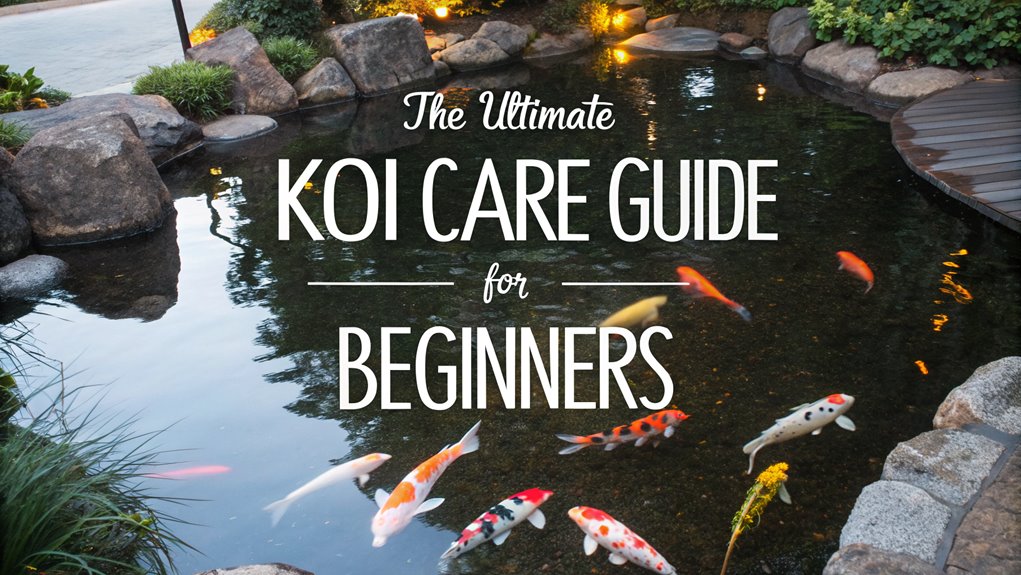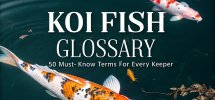To guarantee your koi thrive, start with a habitat of at least 3 feet depth and 240 gallons per fish. Use a multi-stage filter to circulate water every two hours, maintaining water quality with regular changes. Feed them four times daily in warmer months, with a diet of high-quality koi food, algae, and insects. Temperature control is essential, along with vigilant health monitoring. Begin by mastering these fundamental practices and you’ll uncover even more fascinating aspects of koi care.
TLDR
- Ensure pond depth is at least 3 feet and provides 240 gallons per koi.
- Use a high-quality filtration system to circulate water every two hours.
- Maintain water temperatures between 65 and 75 degrees Fahrenheit for optimal health.
- Feed koi a balanced diet of algae, plants, insects, and specialized koi food.
- Quarantine new or sick koi for 2-4 weeks to prevent disease spread.
Koi Fish Characteristics and Lifespan
When you’re considering keeping koi fish, it’s crucial to understand their distinct characteristics and lifespan to guarantee their well-being.
As intermediate to advanced aquatic companions, koi require proper care, emphasizing water quality and suitable feeding regimens. These fish can grow up to 36 inches, necessitating attention to their expansive habitat.
With ideal conditions, koi possess a remarkable lifespan, often exceeding 50 years, making them a long-term commitment.
Koi are omnivorous; therefore, you should feed your koi a diet rich in algae, plants, insects, and specialized koi food.
Their intelligence allows them to recognize their owners, forming bonds that aren’t common with many community fish.
Proper husbandry guarantees they thrive, highlighting the importance of dedicated and knowledgeable care.
Setting Up Your Koi Fish Habitat
To set up an ideal habitat for your koi fish, start by confirming the pond or aquarium meets specific dimensions—ideally, a depth of at least 3 feet and a minimum water volume of 240 gallons per fish.
Position the koi pond in a partially shaded area to regulate water temperature and prevent overheating. Implement a high-quality filter system that circulates the entire water volume every two hours, supporting beneficial bacteria essential for maintaining a healthy ecosystem.
Regular water changes help control waste and toxins. Quarantine new koi for 2 to 4 weeks to prevent disease transmission. Consult an aquatic veterinarian for health assessments.
For aquariums, confirm a quiet, draft-free location, using a hood to minimize evaporation and escape risks.
Filtration and Water Quality Essentials
Although maintaining ideal water quality in a koi pond can seem intimidating, understanding the essentials of filtration will simplify the process.
Your filtration system should effectively process all pond water at least once every two hours, given the high nitrogenous waste koi produce. Employ a multi-stage filter combining mechanical and biological filtration to sustain healthy water.
Regular water changes, replacing 10-25% of the water every 2-4 weeks with dechlorinated water, keep water quality excellent. Weekly additions of beneficial bacteria help break down waste and stabilize the ecosystem.
Routine monitoring of water parameters such as pH, ammonia, nitrite, and nitrate levels is indispensable. By ensuring precise control over these factors, you’ll foster an environment conducive to your koi’s well-being.
Ideal Temperature and Dietary Needs
For maintaining ideal health and activity levels in koi, make sure water temperatures remain between 65 and 75 degrees Fahrenheit. This range supports proper metabolic function and overall well-being.
As an aquatic specialist, you should provide a balanced diet tailored to the koi’s specific dietary needs. Koi are omnivorous, requiring a mix of algae, plants, insects, and high-quality koi food.
During warmer months, feed outdoor koi four times daily, making certain each session lasts around five minutes to prevent overfeeding. Indoor koi’s feeding schedule should adapt to seasonal temperature variations, with reduced frequency in cooler months to maintain appropriate health.
A well-maintained koi pond, aligned with these parameters, guarantees your koi thrive in a suitable environment.
Recognizing and Addressing Health Issues
Maintaining the right temperature and diet is key, but recognizing health issues in koi is equally essential for ensuring their well-being. Healthy koi have clear eyes and an active appetite. Monitor for signs like loss of appetite or labored breathing, which may indicate health issues such as fungal or bacterial infections. Conduct regular water quality testing to prevent disease exacerbation. Isolate new or sick koi for 2 to 4 weeks in quarantine to protect the aquatic species in your pond.
| Health Indicator | Potential Issue |
|---|---|
| Clear eyes | Healthy koi |
| Loss of appetite | Fungal infections |
| Color fading | Water quality issues |
| Labored breathing | Bacterial infections |
Recognize these signs promptly to maintain a thriving environment for your koi.
The Importance of Proper Veterinary Care
While koi are resilient creatures, enlisting proper veterinary care is essential for ensuring their long-term health and vigor. Regular checkups, ideally annual or biannual, are critical components of koi care. They allow aquatic veterinarians to monitor for health problems and provide preventative care.
Specialized assessments can preemptively identify issues like fungal infections and bacterial infections, ensuring timely interventions. Aquatic veterinarians, trained in ichthyology, offer expertise tailored to koi, enhancing their longevity. Cultivating a professional relationship with such experts is important.
They conduct habitat evaluations and offer advice to optimize koi environments, preventing stress-induced ailments. By actively engaging in veterinary care, you’ll contribute positively to your koi’s well-being, supporting their average lifespan of over 50 years with proper care.
Selecting and Introducing Tank Mates
Beyond regular veterinary care, guaranteeing harmonious companionship in your koi pond can markedly enhance your koi’s quality of life. Koi thrive in schools, so keep at least five to mitigate stress.
When selecting community fish, choose those that tolerate 64 to 75 degrees Fahrenheit for ideal compatibility. Quarantine new fish for two to four weeks before introducing them to the pond to prevent disease transmission.
- Introduce new fish gradually: Monitor water parameters closely for stability.
- Avoid overcrowding: Excessive population increases stress and disease risk.
- Select compatible species: Confirm they share similar environmental needs.
These practices help create a balanced aquatic ecosystem. By carefully selecting and managing your tank mates, you establish a thriving community that benefits both koi and their companions.
Koi Keeping Hobby and Community Engagement
Engaging with the koi keeping community offers a wealth of resources and insights that can greatly enhance your understanding and enjoyment of the hobby.
Joining local Koi clubs is essential for accessing expert Koi Fish Care advice. These clubs often host monthly meetings where you can learn Koi care tips, health monitoring practices, and current trends. Networking with fellow enthusiasts and local veterinarians at these events guarantees you maintain healthy Koi.
Participating in community events like Koi swaps and educational workshops expands your knowledge base and connects you with passionate hobbyists. Annual Koi shows foster camaraderie, allowing you to showcase your fish while learning from judges’ assessments on body conformation and color.
Embrace these opportunities to elevate your Koi keeping journey.
Frequently Asked Questions
How to Take Care of a Koi Fish for Beginners?
Start by providing a pond with at least 3 feet depth and 240 gallons per koi. Offer a balanced omnivorous diet, test water quality regularly, quarantine new arrivals, and consult an aquatic veterinarian to guarantee their health.
What Is the Beginner Guide for Koi Fish?
If you want to “dive into the deep end,” guarantee your koi habitat has proper depth and volume. Maintain water quality with regular tests and changes, feed a balanced diet, and quarantine newcomers to prevent disease.
Why Add Baking Soda to Koi Pond?
You’ll add baking soda to your koi pond to increase pH levels, ensuring stability within the ideal 7.0-8.5 range. It buffers against fluctuations, enhancing water hardness, which prevents gill disease and supports koi osmoregulation.
What Is the Best Koi for Beginners?
Imagine koi as living jewels in your pond. Start with Kohaku, Taisho Sanke, or Showa varieties. Their genetic resilience, vibrant chromatophores, and adaptability make them ideal. Choose koi over 6 inches to guarantee robust physiological homeostasis.
Conclusion
In the grand tapestry of koi care, you’ve now woven the essential threads to guarantee your piscine companions thrive. By mastering their habitat setup, maintaining ideal water quality, and understanding their dietary needs, you’ve embraced the role of aquarist with aplomb. Keep a vigilant eye for health anomalies and engage with the koi community for continuous learning. Remember, even in this digital renaissance, nurturing these vibrant creatures requires timeless dedication and passion. Your koi journey is just beginning—enjoy every moment.


